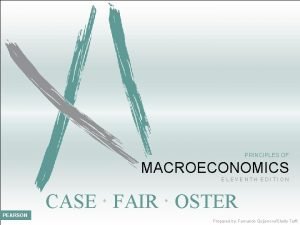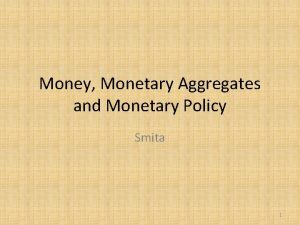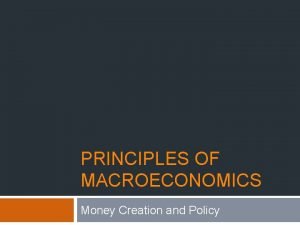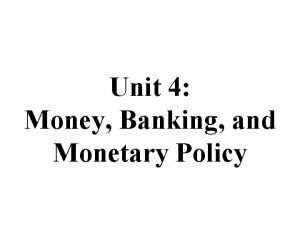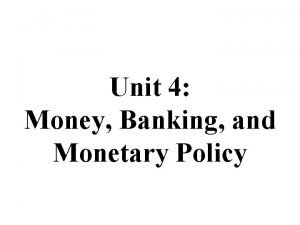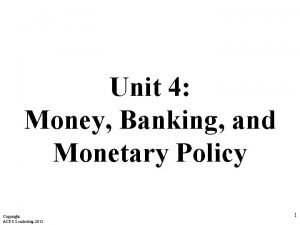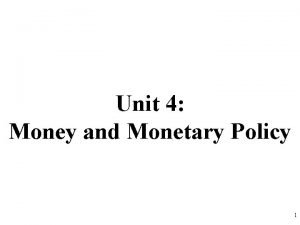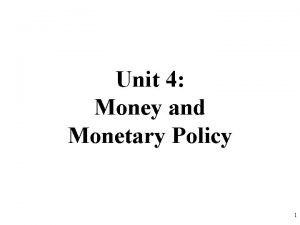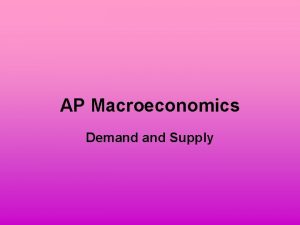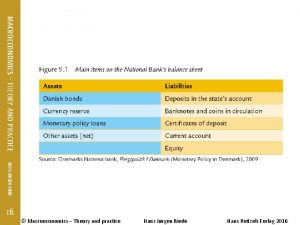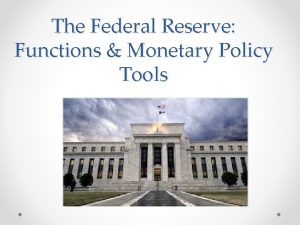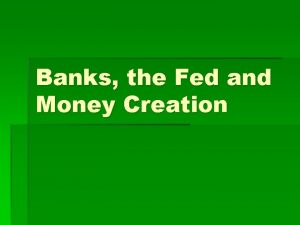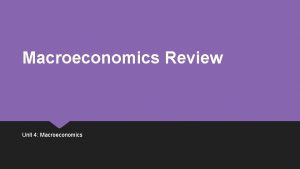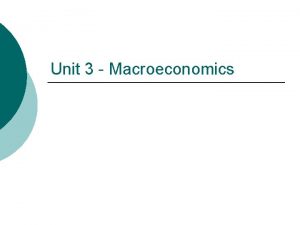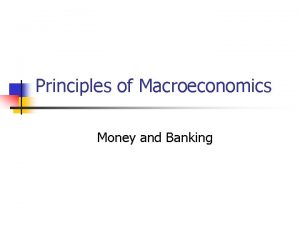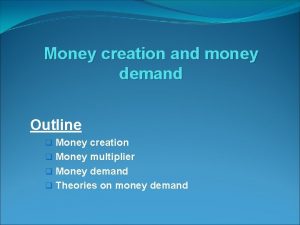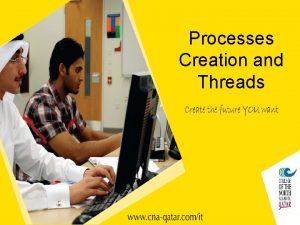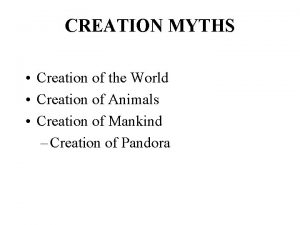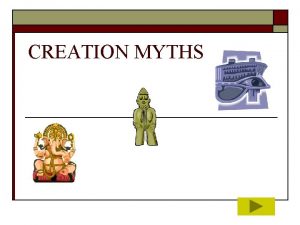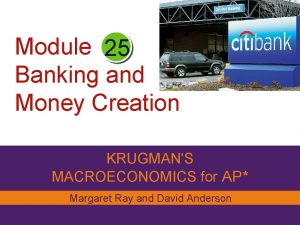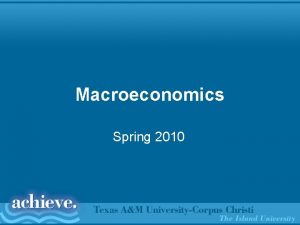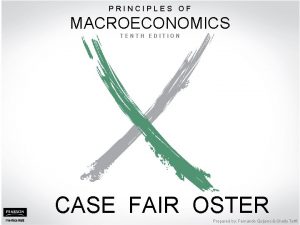PRINCIPLES OF MACROECONOMICS Money Creation and Policy Money

















- Slides: 17

PRINCIPLES OF MACROECONOMICS Money Creation and Policy

Money Creation Learning Objectives � How is Money created? � The role of the banking system � The Money Multiplier

Money Creation How is Money Created – Example � Sam received from his grandpa $100, which he deposits at Bank A. � Bank A needs to hold 20% in reserves and can loan out another $80. Bank A makes a loan to Mary. � Bank A therefore acquired an asset worth $100 in cash and liability worth $100. Bank A Assets Liability Loan $80 $100 Reserves $20

Money Creation How is Money Created – Example � Mary buys with the $80 a pair of shoes, which the shoe store owner deposits at Bank B. � Bank B then acquires assets and liabilities worth $80. Bank B’s assets consist of $16 in reserves (0. 2× 80=16). It also makes a loan of $64 to Emanuel. Bank B Assets Liability Loan $64 $80 Reserves $16

Money Creation How is Money Created – Example � Emanuel invites from the $64 his sister Mary and brother Sam for dinner. The restaurant owner then deposits the $64 at Bank C. � Bank C then acquires assets and liabilities worth $64. Bank C holds reserves worth of $12. 8 and makes a loan of $51. 2 to another person. Bank C Assets Liability Loan $51. 2 $64 Reserves $12. 8

Money Creation How is Money Created – Example � How much money will be created? � First of all, we need to define money terms: Monetary base: Cash (Bills and coins) plus reserves M 1: Monetary base plus immediately available deposits M 2: M 1 plus deposits with short term (3 months) accessibility � Therefore, our example deals with M 1. So how much M 1 is being created?

Money Creation How is Money Created – Example � Money creation = 100 + 80 + 64 + 51. 2 + 40. 96 + 32. 768 + 26. 2144 + 20. 91752 … = 500 The money multiplier associated with an initial deposit of USD 100 when the reserve ratio is 20% is therefore 5! Money multiplier = MM=1/rr where rr=reserve ratio.

Money Creation Proof that MM=1/rr. Assume federal reserve issues $1, which ends up as a deposit in some bank, then the money creation series can be written as � S 1=1+(1 -rr)2+…+(1 -rr)n � We want to know the sum of S 1. Create a second series by multiplying S 1 by (1 -rr) � S 2 = (1 -rr)S 1= (1 -rr)1+(1 -rr)2+…+(1 -rr)n+1 � By subtracting S 2 from S 1, we get � S 1 -(1 -rr)S 1=1 -(1 -rr)n+1. Because (1 -rr)n+1 0 as n infinity, S 1 -(1 -rr)S 1=1. � Therefore, S 1(1 -(1 -rr))=1 S 1(rr)=1 S 1=1/rr q. e. d

Money Creation Leakages � Of course, in practice, the money multiplier is much less, which is because of leakages, which us that banks do not choose to lend all of their excess reserves. � Leakages are largely due to the economic outlook. The more banks expect loans to default, the smaller will be the money multiplier.

Money Creation Federal Reserve Policies � Discount Rate – Rate at which banks can borrow short -term from the Fed (typically to cover minimum reserves) � Open Market Operations – This is the main tool of monetary policy. How does it work? Expansionary monetary policy: FED buys bonds. People who sold bonds deposit money in banks. This increases reserves and banks make more loans. Interest rates go down, money in the banking system is less scarce. Restrictive monetary policy: FED sells bonds. People who buy bonds need to withdraw money from the banks. This decreases reserves and banks make less loans. Interest rates go up, money in the banking system is more scarce.

Money Creation Open Market Operations Step 1: FED buys treasuries with short term maturity. Bond prices go up, yield goes down. Step 2: Money from FED purchases of bonds is deposited in banks, where it increases reserves. This leads to less interbank loans, which reduces the so-called Federal Funds Rate (the rate at which banks lend each other funds) and allows for more loans to the real sector of the economy.

Monetary Policy Does monetary policy affect GDP? � No, is according to the quantity theory of money, which M V = Y P or, assuming V =constant =1 M = Y P P = M/Y è Therefore, an increase in M only increases the price level. This is the classical, long-run, perspective. An increase in the money supply does not affect Y. In other words, Y≠F(M). Keynesian, however, disagree! è For Keynes, monetary policy shifts the AD to the right.

Monetary Policy As the central bank increases the money supply, real interest falls and the quantity demanded for money increases. For what is money demanded?

Monetary Policy Money (Liquidity, L) is demanded � to conduct transactions, which is a function of income LT = F(Y) as Y↑ LT↑ � to conduct speculations, which is a function of the real interest rate LS = F(r) as r↑ Ls↓

Monetary Policy How does monetary policy affect Y? � Answer: M↑ r↓ I ↑↓ Y ↑

Monetary Policy The Effectiveness of Monetary Policy in the Keynesian, “normal”, and classical world

Money Creation Summary � How is money created? � Understand how Open Market Operations affect money supply of banking system, bond rates, and interest rates for investable funds.
 What is the fiscal policy
What is the fiscal policy Money money money team
Money money money team Principles of macroeconomics case fair oster
Principles of macroeconomics case fair oster Money supply and credit creation
Money supply and credit creation Creation of money
Creation of money Unit 4 money banking and monetary policy
Unit 4 money banking and monetary policy Unit 4 money banking and monetary policy
Unit 4 money banking and monetary policy Unit 4 money and monetary policy
Unit 4 money and monetary policy Unit 4 money and monetary policy
Unit 4 money and monetary policy Unit 4 money and monetary policy
Unit 4 money and monetary policy Examples of micro economics
Examples of micro economics Macroeconomics? - definition and examples
Macroeconomics? - definition and examples New classical macroeconomics
New classical macroeconomics Ap macroeconomics supply and demand analysis
Ap macroeconomics supply and demand analysis Macroeconomics theory and practice
Macroeconomics theory and practice New classical and new keynesian macroeconomics
New classical and new keynesian macroeconomics Monetary policy
Monetary policy Contractionary monetary policies
Contractionary monetary policies


